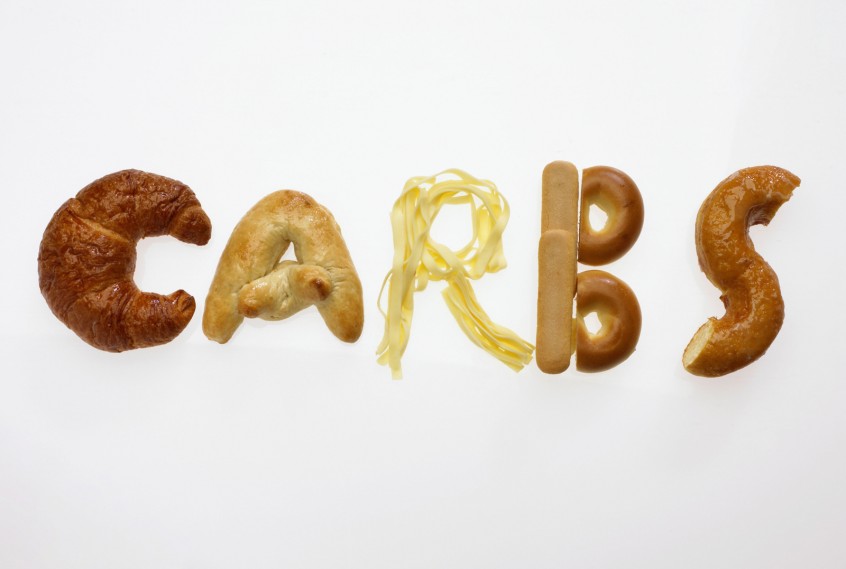Last week I commenced study for my Masters of Nutrition! As I complete my Masters of Nutrition, I will share with you my learnings through my PB-Log (Blog). This not only helps my study but I also hope you will learn something too!
This week’s topic is An Introduction into Carbohydrates.
Firstly, what are carbohydrates?
Simply put, carbohydrates are molecules of varying sizes containing carbon, oxygen and hydrogen.
All carbohydrates are long molecule ‘chains’ made up of a varying number of individual molecule ‘links’. These ‘links’ are called monosaccharides (mono-, meaning one, saccharide, being a ‘simple sugar’). There are only three kinds of these monosaccharide ‘links’ that make up the long chains which are called polysaccharides (poly, meaning many). The three monosaccharides are glucose, fructose and galactose.
Chemically, the three sugars have the same formula, C6H12O6 , however their structures change slightly. This effects the way they taste (fructose is the sweetest, then glucose and galactose is hardly sweet at all) as well as the way they are metabolised.
[Please excuse my hand-written study notes! I find hand-writing things a lot more penetrative for my study]In a broad sencse we divide carbohydrates up into two groups; Sugars and Polysaccharides.
Sugars
This ‘sugar’ category includes the three monosaccharides above – glucose, fructose and galactose – as well as disaccharides. Disaccharides are chains with only two links. There are 3 types of disaccharides, each contains a glucose molecule and then one other:
Sucrose: glucose-fructose
Lactose: glucose-galactose
Maltose: glucose-glucose
Sucrose is what table sugar is made of and it’s also found in fruits and vegetables (along with individual molecules of fructose and glucose), lactose is the sugar found in dairy products while maltose is formed whenever longer polysacchides break down (eg. during digestion an fermentation).
Polysaccharides
Under the polysaccaride ‘umbrella’ we have the following groups:
Oligosaccharides:
Chains of 3-10 monosaccharide units found in many plant foods, especially beans and legumes.
Glycogen:
Our body stores energy (glucose), in the form of glycogen chains in the liver and in the muscles for quick use when needed.
Starch:
Long chains (some are branched, while others are relatively unbranched) of only glucose units. Plants store energy as starch, then when we eat the plant, enzymes in our saliva, small intestine and acid in the stomach break down starch, into the individual glucose units so they can be absorbed from the small intestine into the bloodstream and used for energy.
The monosaccharides and disaccharides found in food will be broken down and absorbed more quickly than longer molecules. This is why you might feel like you have lots of energy right after eating lollies, a sugary drink or even some fruit whereas the energy is more slowly released after eating brown rice, sweet potatoes or whole grains.
Resistant Starch is starch that is not able to be digested by our bodies for one of a number of reasons.
- The starch molecules may be physically inaccessible by our enzymes (within a plant cell that can’t be penetrated in our bodies), like in whole grains, legumes and seeds.
- The starch molecules may be so tightly packed together that our enzymes can’t break them down. For example in uncooked potatoes, unripe bananas and high-amylose corn and rice. Cooking/ripening helps to break up the tightly packed molecules and make them accessible to the enzymes.
- The starch molecules have been ‘retrograded’. This happens when we cook a starchy food then cool it. Upon cooling, the molecules pack together tightly and are less accessible to digestive enzymes than when hot. For example cooked then cooled potatoes, rice, pasta, legumes, even bread and cooked cereals.
Resistant Starch passes through the small intestine and provides a similar role as Fibre.
Fibre:
Also known as non-starch polysaccharides, fibre are long chains of monosaccharides found in plant foods. Fibre, eg. cellulose, is what gives plants their structure. Fibre chains consist of the same 3 monosaccarides, however the bonds between them are different, meaning that our digestive enzymes are unable to break them down and they pass through our body, contributing very little or no energy.
Fibre is very important for digestion.
- It can help lower cholesterol by binding to bile in the gut, the bile cannot be re-absorbed and so is excreted. New bile then needs to be manufactured – which uses cholesterol – in the gall bladder.
- Fibre helps to slow the transit of food through the gut meaning that energy and nutrients are more consistently absorbed by the body after eating (rather than being absorbed all at once).
- Soluble fibre forms viscous cells which delay the rate that food is emptied from the stomach, making you feel fuller for longer.
- An array of bacteria live in the colon (large intestine) use fibre as their energy source. Valuable by-products of the bacterial fermentation of fibre are used by the colon and liver. Short Chain Fatty Acids (SCFA) are one of these by-products. SCFAs lower the pH in the colon, keeping the balance of bacteria in check and acitvating cancer-killing enzymes. One particular SCFA is butyrate which is actually fuel for the cells in the wall of the colon.
- Insoluble fibre helps to increase the bulk of material in the gut. It also attracts water, softening food components, leading to smoother transit and softer, larger faeces.
Sources of soluble fibre: whole grain products, apples, citrus fruits, vegetables, legumes, seeds, husks.
Sources of insoluble fibre: brown rice, fruits, legumes, seeds, carrots, cabbage, brussel sprouts, wheat bran, whole grains.
Stay tuned for further updates and new topics!




